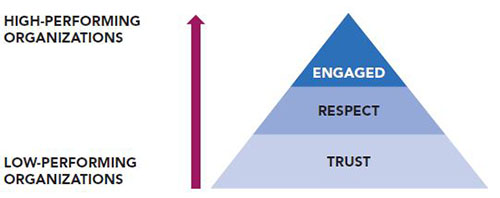
COMPLACENCY

Complacency has been identified as one of the top causes for safety issues and quality escapes. Since we recognize that, why does it remain the top of the list? For one thing, we “accidentally on purpose” keep it there because we are complacent on complacency. I will describe the psychological reasons for this phenomenon. It will be counter-intuitive and run in the face of traditional lines of thinking. First is a statement of clarity: complacency is not a cause.
Complacency is one of the Dirty Dozen. Although it is pointed to as a cause, it is a complex symptom that results from many things.
Large organizations always have a disclaimer attached to their notices, so to put on appearances that I can swim in the big boy pool and as not to feel slighted, I am going to add a disclaimer. Disclaimer No. 1: what I am going to describe is ONE causal path for complacency, not the ONLY causal path of complacency. You will see how this one causal path spiders out into many root causes.
This is one of the reasons for my caution with the Dirty Dozen. It is a great list of characteristics but it does not supply reasons. It is too often viewed as a causal list — 12 simple items that can be pointed at and one can say, “That’s the cause.” Cut and run, we are done and free to pursue other issues and not get tied up with nasty, time-consuming and cumbersome root-cause analysis.
Imagine going to your doctor with a terrible headache and the doctor referred to the Rememdium Duodecim, the 12-page medical diagnostic manual. “I found the cause in the Rememdium Duodecim and the book states that your condition, in medical terminology, is pain,” says the doctor. “Do you want me to explain what that means in layman’s terms?” You decline the interpretation and prefer to go right to the cure. The doctor waves the enchanted pencil over your head and recites the mystical words, “Oogity boogity, the pain has gone away. Goodbye — pay on your way out and don’t let the door hit you in the ass.” How satisfied would you be with that? Do you think that the problem is fixed? Why accept this in our workplace?
Disclaimer No. 2: the “Rememdium Duodecim,” “Medical Dozen” or any similar term is fictitious. I made these up. Disclaimer No. 3: any resemblance to any document titled Rememdium Duodecim, Medical Dozen or any similar-sounding term or document is purely coincidental.
Now the question that should be asked is, “Why is there complacency?” Dig deep for the causes — this is plural because rarely will you find just one cause. You should uncover a multitude of causes, but for brevity in this article I am only going to pursue one path.
Complacency is built into the system by management to prevent complacency. That isn’t the intended purpose but it winds up being the outcome by pursuing compliance. Compliance breeds complacency. Yes, this is counter-intuitive. How many organizations do you know of in which when there is a problem, the first thing that is done is to find and persecute a victim, then write a policy to address the problem? I worked at one organization that had a robust root-cause analysis program but its application was totally convoluted. The policy was to first administer disciplinary action to those involved, then conduct a thorough root-cause analysis. Yes, you read that correctly. It sounds like the narrative from a Dilbert cartoon.
That process further distanced the workforce from management and put another brick in the wall, fortifying compliance. Why would (or how could) a workforce be consciously committed to a process when the focus is on blind compliance? Blind compliance opens the door for malicious compliance for the actively disengaged employees and permits others to be complacent. “I just do what I’m told, that’s it.”
The workforce is made to abide to the policy and rules strictly, even when they know it is going to cause a problem. “That’s the policy” is their only defense when things go wrong. “That’s what the supervisor told me to do and I have witnesses.” The workforce will use it as protection when things go wrong because they have no other option.
Common thought of complacency is that the individual is working without thinking or thinking about something else. Complacency is also following the rules and policies precisely, with or without conscious effort (blind obedience). Zero tolerance is ultimate compliance with all thought processes removed, building in complacency. Any deviation is a discrepancy and the degree and reason is inconsequential. Zero tolerance is also management’s declaration that they don’t trust a supervisor’s ability to reason and think logically or ethically, so it is removed from the equation. Shades of gray are removed so that everything is black or white.
Management can also contribute to complacency inadvertently with placement of fear, either real or imagined. Command and control management is directly fear driven — but absent of that, workers might also worry about layoffs, loss of pay and benefits, personal issues, etc. These all affect a person from not being fully engaged in his/her primary activity. Other symptoms from the Dirty Dozen will manifest themselves as well: stress, distraction, lack of awareness and pressure. Again, read the word “symptoms,” not “causes.” Much work needs to be done. The Dirty Dozen just supplies a starting point.
Where do you want to be? You want your employees to be committed to the processes, not just compliant. Three forces are in play in every organization: control, culture and climate. The control is your policies, procedures and processes, and these represent the ideal state. The culture is the norms, values, customs and behaviors, and these represent the real state. Then there is the climate — this is what people feel and think about the culture and control, and it represents the cognitive state. When all three conditions are in alignment, it reflects high-performance organizations. Wouldn’t it be nice to have an organizational atmosphere where the rules and policies are actually ingrained into everyday employee behaviors? What if there was a conscious and collective focus on one vision and concerted effort to improve continually? Unfortunately, this is not a solid state condition, as the organization is influenced by internal and external forces. The alignment state is built with an engaged workforce on a base of mutual respect with a foundation of trust. This alignment is only temporary. Misalignment is the system’s method of signaling that an improvement opportunity is present.

Often organizations try to instill employee engagement and the efforts are miserable failures. The numbers tell the story. I used to be appalled at the Gallup poll results that only 1/3 of employees are engaged in their work (with 1/3 not engaged and the other 1/3 actively disengaged). Those who are not engaged are just not interested, will put forth minimum effort to avoid getting fired, and are a relatively harmless group of people who are non-contributing and not working to their potential. Those who are actively disengaged are your organizational saboteurs who seek to disrupt activities. They can be extremely dangerous. The latest polls put worldwide employee engagement as low as 13 percent and as high as 17 percent. Employee engagement is on the decline and our engagement efforts are not working. Fortunately, the actively disengaged numbers has remained at about 1/3. The benign, not engaged group is growing but they are compliant, so it’s OK, right?
You can’t focus on engagement without other factors being in place. You also need mutual respect and trust. You also need a sound corporate structure with a singular focus, but one does not supplant the other. We are talking about the people part. You can’t have respect without trust and you aren’t going to get engagement without respect. Where are you on this pyramidal hierarchy? Most will have to work on the trust factor before proceeding — this is a behavior change.
“Creating Cultural Change: The Key to Total Quality Management,” a study conducted by Phillip Allison in 1990, found that 80 percent of companies are not interested in organizational culture. Other research has confirmed these abysmal figures.
“Who needs all that aggravation? It’s too much work. We pay them and they work — it’s that simple.” There is something to be said for that. It works but it suppresses the employees from putting forth their full potential. It either diverts attention of the supervisory staff or dilutes their capability. This decreases their performance and is just plain exhausting. Simply put, it’s inefficient. If you are shooting for compliance, you need extra oversight to ensure workers are doing what they are supposed to be doing. People will only be compliant if they have to be. If there is looming punishment from getting caught, they will only be compliant when they are being watched. Compliance becomes labor intensive. Then you will need managers to oversee the supervisors to ensure they are compliant, and need general managers to oversee the managers to ensure compliance there, and so on up the food chain. Then their attention is diverted from doing their primary jobs, thus decreasing performance. Support for the workers is reduced; they now cannot perform efficiently because of the lack of resources. If compliance is all you require, then more power to you. You have hampered your processes, so don’t expect to achieve high performance goals. You also are missing out on so much more.
Engaged employees are more productive, produce higher quality, are more creative, are absent less, are injured less, are healthier and are resilient to economic changes. They take responsibility and they are able to contend with problems as they occur. They don’t wait for supervisory intervention. Need I go on? (I will save details about high-performance organizations for future articles.) You can get there if you want. It’s your choice: compliance or commitment? Any organization can duplicate your product or service, but they can’t duplicate the culture in which it is produced. It isn’t a matter of bad or good, but of good or excellent.
 Patrick Kinane is an FAA-certificated A&P with IA and commercial pilot with instrument rating. He has 50 years of experience in aviation maintenance. He is an ASQ senior member with quality auditor and quality systems/organizational excellence manager certifications. He is an RABQSA-certified AS9100 and AS9110 aerospace industry experienced auditor and ISO9001 business improvement/quality management systems auditor. He earned a bachelor of science degree in aviation maintenance management, a master’s of science degree in education, and a Ph.D. in organizational psychology. Kinane is presently a senior quality management systems auditor for AAR CORP and a professor of organizational behavior at DeVry University.
Patrick Kinane is an FAA-certificated A&P with IA and commercial pilot with instrument rating. He has 50 years of experience in aviation maintenance. He is an ASQ senior member with quality auditor and quality systems/organizational excellence manager certifications. He is an RABQSA-certified AS9100 and AS9110 aerospace industry experienced auditor and ISO9001 business improvement/quality management systems auditor. He earned a bachelor of science degree in aviation maintenance management, a master’s of science degree in education, and a Ph.D. in organizational psychology. Kinane is presently a senior quality management systems auditor for AAR CORP and a professor of organizational behavior at DeVry University.
